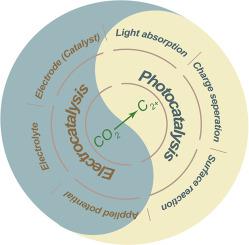Materials Today Advances ( IF 8.1 ) Pub Date : 2020-04-26 , DOI: 10.1016/j.mtadv.2020.100071 C. Du , X. Wang , W. Chen , S. Feng , J. Wen , Y.A. Wu

|
The excessively high atmospheric CO2 concentration is associated with rapidly evolving industrial, commercial, and residential uses of fossil fuels, which has caused global warming and climate crisis. Photocatalytic or electrocatalytic reduction of CO2 into value-added hydrocarbon fuels has provided a promising and sustainable solution to addressing these issues simultaneously. Multicarbon products (C2+) with higher energy densities are generally desirable in fueling transportation and other industries. However, the low selectivity and subsequently a higher cost toward these C2+ products have severely limited their larger scale production. Here, we review the strategies of controlling the C2+ product selectivity during the photocatalytic and electrocatalytic CO2 reduction reaction (CRR) processes with their catalytic reaction mechanisms. This review starts with the fundamentals on photocatalytic and electrocatalytic CRR, which is followed by discussions about how reaction mechanisms and process pathways affect the C2+ product selectivity and the main strategies to improve both photocatalysis and electrocatalysis systems. Finally, some outlook for future work and challenges in improving the C2+ product selectivity is included.
中文翻译:

通过光催化和电催化将CO 2转化为多碳产物
大气中CO 2浓度过高与化石燃料的工业,商业和住宅用途的迅速发展有关,这已导致全球变暖和气候危机。光催化或电催化将CO 2还原为增值的烃类燃料,为同时解决这些问题提供了一种有前途且可持续的解决方案。具有较高能量密度的多碳产物(C 2+)通常在为交通运输和其他工业提供燃料时是理想的。然而,对这些C 2+产物的低选择性以及随之而来的较高成本严重限制了它们的大规模生产。在这里,我们回顾控制C 2+的策略在光催化和电催化CO 2还原反应(CRR)过程中的产物选择性及其催化反应机理。这篇综述从光催化和电催化CRR的基础知识入手,随后讨论了反应机理和过程途径如何影响C 2+产物的选择性以及改善光催化和电催化系统的主要策略。最后,包括对未来工作的一些展望以及在提高C 2+产品选择性方面的挑战。











































 京公网安备 11010802027423号
京公网安备 11010802027423号